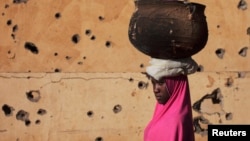GENEVA —
The U.N. Office for the Coordination of Humanitarian Affairs warns that inhabitants of Gao in eastern Mali are suffering from a severe water shortage. The shortage is a result of fighting in the area, which has damaged the local infrastructure and made it dangerous for aid agencies to bring in water by truck.
A joint U.N. mission to assess conditions in Gao found the amount of drinking water available to people has declined by 60 percent in recent weeks, leaving about 70,000 inhabitants extremely vulnerable.
OCHA spokesman Jens Laerke outlines the dire situation.
“Some neighborhoods in Gao do not have water at all due to dysfunctional pumps and lack of electricity. Outside of the city the situation is even worse because the Niger River is the only source of water and there are concerns about cholera outbreaks. The water is not clean. Already 22 cases of cholera have been registered in May, and two people have died from the disease. However, no new cases have been reported in the past five days, but the risk of cholera remains very high," he said.
Laerke says the mission also reported a food shortage in Mali, and called for food assistance to be increased immediately.
There is no drought in eastern Mali. The water shortage stems from fighting between French-led military forces and Islamist militants that knocked out Gao's power generator. Laerke says locals don’t have spare parts to fix the generator, so they are unable to pump water into the pipes.
The ongoing insecurity is also preventing the U.N. from sending in water by truck. Unexploded bombs have caused some casualties among local residents. So Laerke says the U.N. believes that fixing the water supply system is the best way to relieve the shortage.
The U.N. Children’s Fund is one of the many aid agencies present in Gao. UNICEF spokeswoman Marixie Mercado says aid workers have been providing household water treatment supplies to communities in northern Mali for months.
“We have also provided chlorine to treat water systems. We are working now to rehabilitate a lot of the damaged infrastructure. We are training a lot of the community health workers, and leaders, and teachers, etc. on hygiene and just hygiene-protective behaviors... Vaccinations have been happening when and wherever possible," he said.
Mercado also says a major chronic nutritional crisis is affecting children in Mali, particularly in the south where 90 percent of the population lives.
She says UNICEF expects 210,000 children will require life-saving treatment for malnutrition this year. She says 450,000 other children also will suffer from a less severe, but debilitating form of malnutrition.






